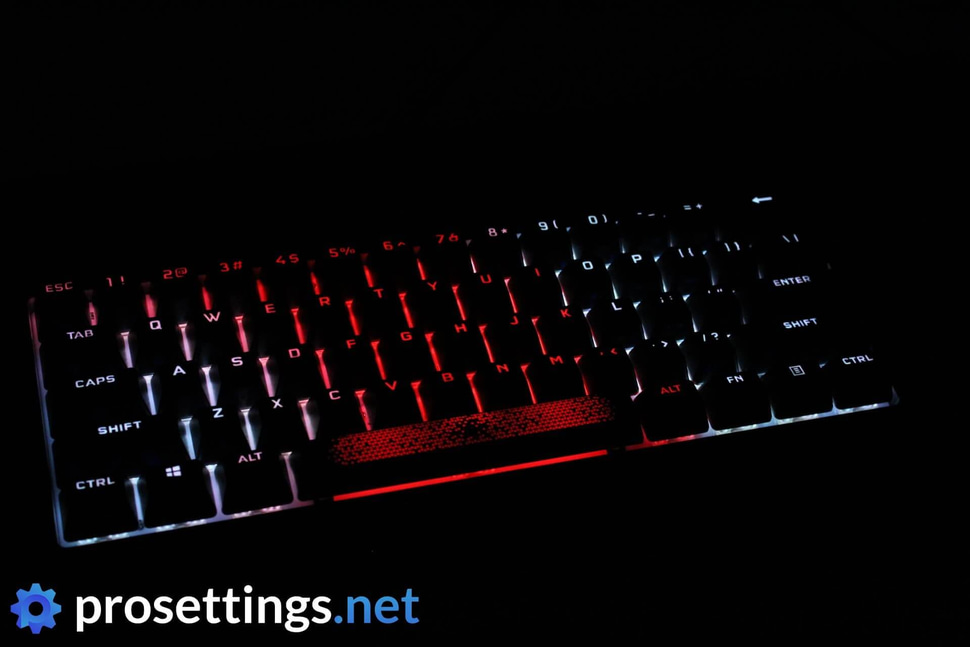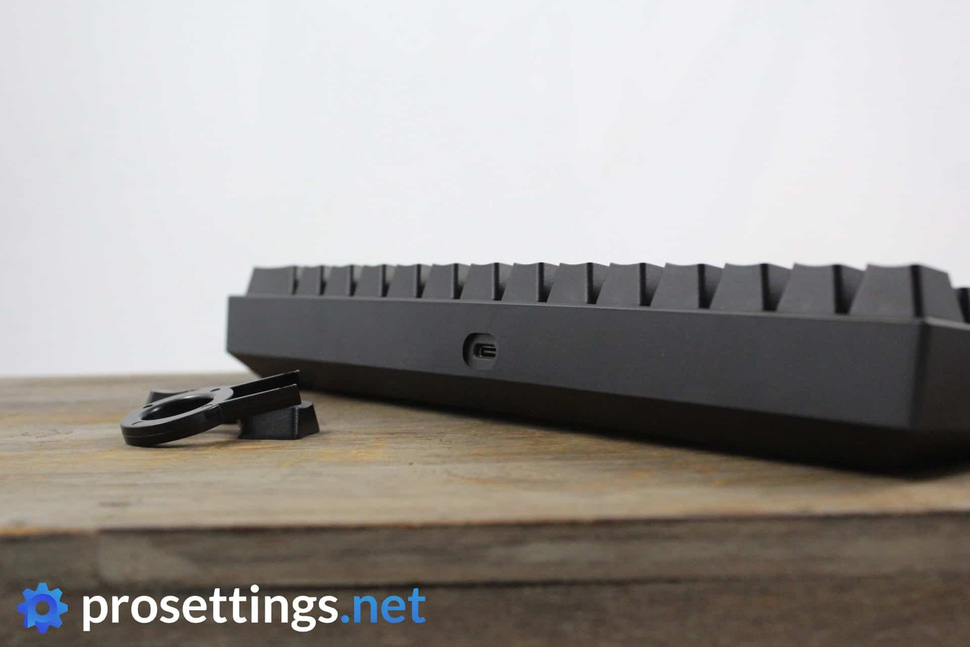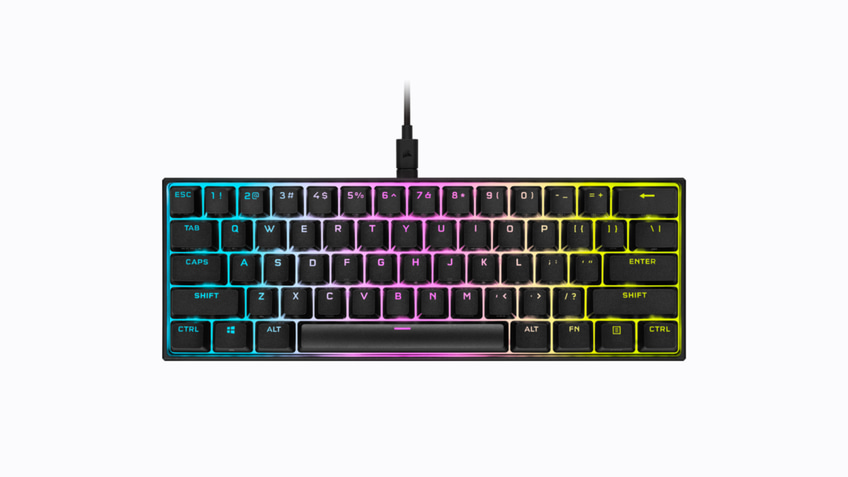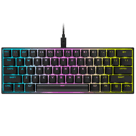Introduction
The custom keyboard community has been growing over the past couple of years, and with that the desire for more ‘uncommon’ keyboard sizes. Multiple mainstream brands known for their big and expansive full size keyboards are now also offering much smaller versions, and this K65 RGB Mini is the latest keyboard from a huge manufacturer to follow that trend.
Coming in hot with Cherry MX switches, PBT keycaps, a detachable USB-C cable, and a standard bottom row, this should be the ideal mini board for people who love Corsair’s products. The fact that it comes with their AXON Hyper-Processing Technology is just the cherry on top. Is this board worth it, now that the market for these kinds of mini keyboards is getting larger and larger? Read our full review to find out!
At A Glance
Corsair K65 RGB MINI 60%
Used by 2 players ()Perhaps this would’ve been a lot more impressive 1.5 years ago but the keyboard market has moved a lot in that time, both for mass produced boards as well as custom built ones. In a nutshell: it’s an okay and rather unimpressive 60% board. Nothing more, and also nothing less.
Pros
- Decent stabilizers
- Nice looking RGB
- Decent keycaps
Cons
- Feels and sounds a little hollow
Specs
| Form Factor | 60% |
|---|---|
| Switches | Cherry MX Red, Cherry MX Speed, Cherry MX Brown, Cherry MX Blue, Cherry MX Silent |
| PCB | Non-Hotswappable |
| RGB | Yes |
| Height | 3.4cm |
| Width | 29cm |
| Length | 10.2cm |
| Weight | 573g |
First Impressions
What’s in a name? Not much, according to Corsair. Their last board that I reviewed was a full sized board named the K60 RGB Pro, and now I’m reviewing this 60% board that’s called… K65 RGB Mini. I’m not really complaining: Corsair isn’t the only brand that has confusing naming schemes (hello there, monitor manufacturers) but it’s just an amusing observation.
On to the observations that actually matter, then: does this keyboard impress when you take it out of the box for the first time? Yes and no. I like the fact that they’ve kept the bezels thin and that there’s no obnoxious branding plastered anywhere (the only Corsair logo on the board is placed towards the back and barely visible) and I love the detachable USB-C cable since that’s basically a must for small keyboard in my opinion, but I do have to say that it feels a bit cheap. I’ll get into it more later on, but the plastic that they’ve used for the case initially feels very thin and the entire board just feels light and sort of hollow. Add to that the fact that this isn’t a budget keyboard (I never list specific prices because they can vary so much with sales and regional pricing, but the MSRP places it in the mid tier of ‘big brand production keyboards’) and I’ve got to say I wasn’t immediately blown away upon unboxing the K65 RGB Mini.

The back plate is white, which really helps that Corsair RGB come to life beautifully. If you’re someone who is into RGB lighting Corsair is very much one of the top brands to consider, and that’s still the case with the K65 RGB Mini. The included special spacebar helps the board pop just that tiny bit more.
What’s perhaps a bit odd is that the (detachable) cable connects in the middle of the board. Or at least around the middle, since it’s not in the exact center on my unit. People with OCD beware. The connection isn’t proprietary or anything so it’s entirely possible to connect a custom cable, which is always good news for people with custom coiled aviator cables.
Packaging
Inside the small box you get the keyboard, a quickstart guide along with the usual documentation, the detachable USB-C cable, a keycap puller, and two extra caps. One of those caps is a spacebar replacement in case you don’t want the special ‘radiant spacebar’. There might be a good reason for that, since the radiant bar is made out of thinner ABS plastic and the regular one is double-shot PBT like the other caps. I like that they give you the choice here.
What I also like is that they’ve included a keycap puller. That’s something that I always appreciate with keyboards so it’s nice to see it included here. You can put it to use too, should you want to: the board has a standard bottom row so you’ve got a lot of options as far as aftermarket keycaps go.
Features and Build
As I said earlier, the case is made out of plastic. That doesn’t have to be a problem since a lot of keyboards are plastic. And you don’t really have to worry about the rigidity of the board: I couldn’t really get it to flex or bend, so my initial concerns about the board feeling cheap were somewhat erased after a more careful examination. I say ‘somewhat’ because the thin and hollow case does influence the typing feel and sound, but more on that in the next section.

I suspect most people will be familiar with the different keyboard sizes (if you’re not then you can read our article on it) and as such will know what this one doesn’t have a function row, numpad, or arrow keys. All of those functions can be accessed by pressing the function key (again: what’s in a name?) in combination with the corresponding key on the board itself, so in reality you have the entire keyboard at your disposal. All of the ‘second layer’ functions are printed on the front of the keycaps so even if you’re new to this board it should be relatively easy to figure out unless you’re gaming in total darkness.
The keycaps deserve a special shoutout in my opinion. Most mainstream manufacturers have been using low quality ABS caps for a long time now but it seems like the industry is becoming wise to the fact that most reviewers (and consumers these days) will call them out on that so we’ve got some pretty decent, mildly textured PBT keycaps on this board out of the box. It’s a nice touch, and it makes it so that you don’t have to bother replacing the standard caps if you like the font and style of these existing ones.
On the bottom of the slightly angled case we find four rubber feet, and that’s it. There are no flip up feet to be found, so if you’re someone who likes to set their keyboard at a large angle you’re going to be out of luck. I can’t remember the last time I’ve used these feet on any board though so for me this is all fine.
The included cable has a smooth braiding to it but it is pretty stiff. It is detachable though, and there is (as I mentioned) no proprietary nonsense going on with the connection port so you should be able to connect pretty much any USB-C cable you’d want to it. I’m glad for that. I don’t really care about the connection on wireless mice (since you just charge them and then slide the cable out of sight somewhere, at least I do) but I do know that a lot of people like to use their favorite custom cable with keyboards so it’s good to see that they went with USB-C.
Performance and Everyday Usage
This board can be bought with a variety of Cherry MX switches. Mine came with Reds, and these are switches that hardly need an introduction anymore. They’re not my absolute favorite ones (definitely not since I started exploring custom keyboards and more niche switches when the COVID-19 pandemic started) but as far as linear switches go they absolutely get the job done, and if you’re someone who likes a fast-feeling linear switch you won’t have any issues here.
What is somewhat odd is that Corsair have their own switches (in the form of their optical OPX switches) and still decided to use Cherry MX here. I don’t have a big problem with that: despite the fact that Cherry MX switches have gone out of style with many keyboard aficionados they are probably still very loved and without a doubt the most known brand of switches for most people who aren’t all that interested in this scene, so perhaps it’s just for marketing purposes. There is, however, no option to buy the board with OPX switches, so that’s a bit of a head scratcher.

What I appreciate are the stabilizers: they’re actually pretty nice. The rattling is kept to a minimum and for a mass produced keyboard these are absolutely fine. Sadly the same can’t be said for the acoustics and overall typing feeling. It might be because I’ve been using a custom keyboard (an entry level one though) for the past weeks but this K65 RGB Mini is very loud to me, and even though the actual sound that it produces isn’t downright bad (thanks, in part, to the stabilizers) there’s a slightly hollow feeling and sounding touch to this keyboard that I don’t particularly like, even when comparing it to other mass produced boards. These things are very subjective though and it by no means impacts the performance of the board, so make of that what you will.
Powering this board is the AXON Hyper-Processing tech. This allows you to get a polling rate of 8000Hz, making it, theoretically, one of the fastest keyboards in town. This tech isn’t new to Corsair, and just like before I have to say that I appreciate their forward thinking but I can’t say that I feel a real difference ingame with this kind of stuff. It’s also less important with a keyboard than it is with a mouse, for example. That doesn’t mean that I think it shouldn’t be included though. It’s always better to have more options as long as they don’t get in the way of the functionality, definitely when those options could be used for potentially future-proofing a product.

The gaming performance is pretty much perfect, as you would expect. Thanks to the N-key rollover you’ll never suffer from a switch that doesn’t get registered, and the nice factory stabilizers and PBT keycaps make this a pleasant board to use all throughout, even for extended gaming sessions. I just wish they made the actual case more dense or added some material inside the case to make it sound a bit less hollow.
The K65 RGB Mini can be controlled through Corsairs iCUE software. This has seen a bit of an overhaul, and while it’s without a doubt one of the most expansive pieces of ‘control software’ out there it still has quite the learning curve to it. That’s fine with me, but if you want to do anything other than quickly change your lighting or whatever you’ll want to reserve some time to get to know the software if you haven’t used iCUE before. The board has full on-board storage though (not only for lighting but also for macros and the likes) so you really only have to download the software once in case you’re someone who doesn’t want to use these kinds of things, or if you’re someone who often plays at different PCs.
Sound Test
Conclusion
All in all the K65 RGB Mini offers a decent experience, both for gaming and regular productivity purposes, but it doesn’t do anything more than that. You could argue that it doesn’t really have to (since people who buy 60% boards usually aren’t interested in a flurry of extra dials and features) but the fact that it’s ‘just decent’ and comes at an MSRP where a lot of other decent boards operate makes it hard for the K65 RGB Mini to stand out. Perhaps this would’ve been a lot more impressive 1.5 years ago but the keyboard market has moved a lot in that time, both for mass produced boards as well as custom built ones.
If you want a 60% board with PBT keycaps, great RGB, Cherry switches, decent stabilizers, and on-board memory then this is certainly one to consider. The problem (for Corsair) is that there are a lot of other boards that offer the same, and the overall typing experience, while decent, doesn’t exactly set this one apart so there’s nothing that really screams ‘pick me’ over other options at the same price. It’s a shame because it ticks a lot of boxes otherwise, and I feel like if they used a case that’s more dense (or added some dampening materials, but I know I’m asking for a lot here) to get rid of that awkward hollow feeling it would really elevate this keyboard.
I also can’t figure out why they don’t at least offer it with their own OPX switches alongside these existing Cherry MX options but that might be due to some marketing reasons that I’m not privy to so I won’t harp on about that.
In a nutshell: it’s an okay and rather unimpressive 60% board. Nothing more, and also nothing less.
This product was received for free from the manufacturer and given to our reviewer to test and review. Brands and manufacturers have no editorial control over our reviews. For more information, check out our review FAQ.









